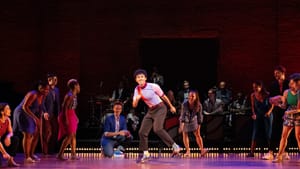Stay in the Loop
BSR publishes on a weekly schedule, with an email newsletter every Wednesday and Thursday morning. There’s no paywall, and subscribing is always free.
The art of Lindy Hop
Caleb Teicher swings at the Zellerbach with Swing Out

Penn Live Arts at the Annenberg closes out its 50th season June 9 and 10 with Swing Out, Caleb Teicher’s love letter to Lindy Hop. I caught up with Teicher between a master class they were teaching and a competition they were judging at the International Lindy Hop Championships in Harlem to learn more about the show and about the 1930s dance craze that is popping up on stage and on Sundays at Rittenhouse Square.
Philly audiences know Teicher for tap dance, but they have been an avid fan of Lindy Hop since they arrived in New York, eager to experience all the dance that the city had to offer. “I was definitely just an enthusiast, a hobbyist,” they said, until they got a job with a Swing dance company in 2013. Since then, it’s been a deep dive into the world of Lindy Hop.
What is Lindy Hop?
Imagine it’s the 1920s at the Savoy, the great ballroom at the heart of the Harlem Renaissance. The jazz is hot and the dancing is hotter: the Charleston gets faster, broader, mingles with Snakehips, Black Bottom, steps going back to the West African roots of Black dance. By the 1930s, the Lindy Hop emerges, named for Charles Lindbergh’s 1927 hop across the Atlantic, from New York to Paris. The Savoy is open to dancers of all colors, so the new craze spreads out into many communities. Movies drop a Black dance number into otherwise all-white casts; Hellzapoppin, in 1941, is considered to have the best Lindy Hop performances on film. New versions of swing dances continue to appear, but the Lindy is what most people think of when they hear “swing” dancing.
Teicher says that Swing Out is purely a Lindy Hop dance show. It begins with a stage performance by 12 dancers and the 10-piece Eyal Vilner Big Band, with big numbers that pull audiences out of their seats and more intimate duets and solos. After the intermission, the band and dancers return for a dance jam, and the audience is invited to join in. The show makes people want to get up and dance, Teicher said, “and so, the second act is our way of opening our arms and saying, ‘try it.’ There’s something to getting up and moving to it, even if your skills or your abilities or your physicality is limited.”
Lindy Hop in the neighborhood
It’s a rare treat to see it onstage, danced by the best of the Lindy Hoppers, but at heart, as Teicher reminds us, Lindy makes you want to get up and dance. So, if you fall in love with the Act 2 Jam, Philly has a scene for you.
Nick Cruickshank, has been Lindy Hopping since he was a member of the West Philly Swingers at Penn and says “the heart, the soul, the lungs of the Lindy Hop community are at the local level.” When I asked him why he Lindied, he talked about being a little down, and having a place “where you can go and you can turn these things into joy, where joy is the output. That’s magical.” Cruickshank spearheads Jazz Attack for lessons and social dancing on Thursday evenings at the Ethical Society. (For dancing al fresco, try Rittenhop on Sunday afternoons at Rittenhouse Square.)
What, When, Where
Swing Out. By Caleb Teicher, presented by Penn Live Arts. $29-$67. Friday, June 9, and Saturday, June 10, 2023, at the Zellerbach Theatre, Penn Live Arts, 3680 Walnut Street, Philadelphia. (215) 898-3900 or pennlivearts.org.
Accessibility
Penn Live Arts offers wheelchair-accessible seating, free admission for personal care attendants, large-print programs, and assistive listening devices. Visit the venue’s accessibility page for more info.
Sign up for our newsletter
All of the week's new articles, all in one place. Sign up for the free weekly BSR newsletters, and don't miss a conversation.

 Camille Bacon-Smith
Camille Bacon-Smith